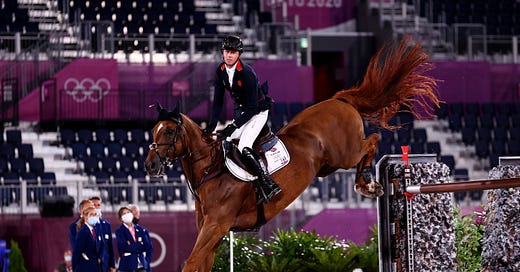Day One of the 2024 Olympics welcomes 11 straight days of Equestrian competition, although the first medal isn’t handed out until day three. As outlined in a previous article, this is my least favorite Olympic event so I’ll be going into less detail than other previews. A total of 200 riders are competing in 6 events.
The Basics
Equestrian comprises three disciplines at the Games, with men and women competing on equal terms.
In the jumping discipline, riders and horses are timed as they jump over obstacles, with time penalties imposed for each obstacle toppled. Agility, technique and harmony between horse and rider are essential.
Dressage is the most advanced form of horse training, where horse and rider perform a series of artistic movements to music. Judges evaluate the ease and fluidity with which they move around the course.
The third discipline of eventing resembles an equestrian triathlon. It combines the two other events—jumping and dressage—with a third: cross-country, which consists of a long course combining solid and natural obstacles, drawing on the athletes’ endurance and experience. The horse and rider with the most versatile skills win the three events.
The Format
In Dressage the first round serves as the qualifier for both the individual and team event. Dressage teams consist of 3 riders. The individual event has 45 riders from those 15 teams, and then 15 “solo” riders. Everyone does one routine scored by judges, and that’s used to determine which 18 riders and 8 teams advance to the finals. The team final has every rider/horse pairing do one routine, with the 3 scores added up. The individual final gives riders a little more creative freedom with their routine and music. Once again, they have just 1 chance to put their best hoof forward and win gold.
In Jumping there are 75 riders and 20 teams of 3. The individual and team events have separate qualifiers. In the Individual event, one run through the obstacle course is used to narrow the field from 75 to 30. Horses accumulate penalties based on jump and time errors. I believe the time error is just taking too long to finish the course. The first criteria for ranking these rider/horse pairings are actually the fewest amount of penalty points. After that, ties are broken by total time. It’s kind of a ridiculous system and it only gets more confusing as we head to the final. In summary, the 30 fastest horses that didn’t make any errors advance. In the final the 30 horses perform a slightly longer obstacle course. All ties are broken by time, except ties for first place. In 2021, the course was easy enough that 6 riders were able to complete it without any penalty points. Rather than just award the medals based on speed, those six advanced to a “jump-off”. This is a much shorter obstacle course where to no one’s surprise all 6 riders were able to complete it without penalties, except this time the tie is broke by total time, and that’s how the medals were awarded.
In Team Jumping there is a separate qualifier event where every rider/horse goes through the course once. The top-ten teams with the fewest penalty points moves on to the final, with ties broken by time. Again, if you complete all the obstacles under a certain amount of time, you have 0 penalty points. The same thing happens in the final, with ties broken by time except a tie for first place. This is the same as the individual event. In 2021 there was also a dramatic “jump-off” between two teams tied for first.
Eventing is a combination event that features Dressage, Jumping, and Cross Country. 65 riders and 16 teams of 3 are competing this year. The individual and team events actually happen at the same time. All 65 riders start with Dressage. The worst scores are eliminated, and the rest move on to Cross-Country, which is a 4.5km obstacle course. Again, the worst scores are dropped, and the remaining riders compete in Jumping. With the scores from all 3 disciplines added together, the medals are awarded for all the teams competing. The top 25 individual athletes move on to a second round of jumping, and those medals are awarded with all 4 rounds added together.
What Countries are Historically Dominant?
Here is the medal table going back to 2008:
#1 Germany (10 gold, 5 silver, 4 bronze)
#2 Great Britain (7 gold, 3 silver, 5 bronze)
#3 United States (1 gold, 4 silver, 3 bronze)
#4 Netherlands (1 gold, 4 silver, 2 bronze)
#5 Sweden (1 gold, 4 silver)
#6 France (2 gold, 1 silver, 1 bronze)
17 out of 24 possible gold medals were won by Germany & Great Britain since 2008.
Schedule
July 27th: Eventing Dressage
July 28th: Eventing Cross-Country
July 29th: Eventing Team Jumping Final & Individual Jumping Final
July 30th: Dressage qualification
July 31st: Dressage qualification
August 1st: Team Jumping qualification
August 2nd: Team Jumping Final
August 3rd: Team Dressage Final
August 4th: Individual Dressage Final
August 5th: Individual Jumping qualification
August 6th: Individual Jumping Final



